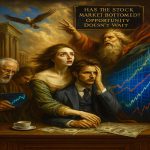What is Panic Selling? The Madness Behind Market Mayhem
April 15, 2025
Panic selling isn’t just a mistake—it’s the market’s darkest reflex, a primal reaction that overrides reason with a wave of blind terror. Investors, caught in the gravitational pull of mass hysteria, throw their assets to the wolves, hoping to escape a disaster that’s often no more than a shadow. This isn’t investing; it’s surrendering to the chaos. Panic selling is the epitome of cognitive collapse, where rationality collides with irrationality, resulting in a storm of fear-driven decisions that erode wealth and hinder the very recovery investors should be capitalising on.
What drives this madness? It’s not the market itself—it’s the psychology of the herd. Fear, like a virus, spreads through the collective psyche, turning rational people into irrational sellers. Nobel laureates Richard Thaler and Daniel Kahneman dissect this twisted logic. Thaler’s research into behavioural economics reveals how cognitive biases, such as loss aversion, entangle investors in irrational decisions, prompting them to sell at the worst possible moment. Kahneman’s insights dive deeper into the contagion effect—emotions spread faster than reason in a panic, and when one investor jumps, the floodgates open.
In these moments, the market isn’t a reflection of economic fundamentals; it’s a pressure cooker of collective insecurity. Warren Buffett’s words echo through this madness: “Be fearful when others are greedy and greedy when others are fearful.” This isn’t a catchphrase—it’s a lifeline. While the crowd panics, the wise make their moves. Panic selling locks in losses; it surrenders potential recovery. The market always rebounds, but those caught in the panic will never see it coming.
Panic selling isn’t just a behavioural flaw—it’s the perfect storm of psychological missteps: loss aversion, herd mentality, and emotional contagion, all intersecting in a catastrophic blind spot. To survive this storm, investors must sharpen their awareness of these forces and tune out the cacophony of mass hysteria. This isn’t about avoiding risk—it’s about understanding and managing the human response to risk. Investors need to see through the smoke of the panic, act where others falter, and rise from the wreckage while others are still scrambling.
Panic selling is the market’s plague, and it’s your discipline, your focus, and your awareness of the human mind’s weaknesses that will ultimately separate you from the wreckage.
The Psychology Behind Panic Selling
Loss Aversion
At the heart of panic selling lies a deep-seated, almost primal fear: the dread of losing one’s possessions. Loss aversion is more than just a bias; it’s a survival instinct gone rogue. The human brain is wired to experience losses as more painful than the satisfaction of gains. A small dip in portfolio value becomes a looming catastrophe, triggering a knee-jerk sell-off to avoid the agony of loss. In volatile markets, this fear metastasises, growing beyond rational thought, forcing investors to cut their losses before they “feel the pain” even more. This emotional reflex blinds them to the truth: the biggest losses come from locking in losses. Fear turns strategy into desperation.
Availability Bias
The media machine feeds on negativity, and the availability bias amplifies its power. This cognitive flaw not only allows investors to remember the worst but also makes them believe the worst is inevitable. When disaster stories dominate the news, investors tend to overestimate the likelihood of their own financial ruin, perceiving risks where none may exist. What’s fresh, vivid, or sensational becomes their new reality. The next wave of market turbulence isn’t an opportunity—it’s an omen. In these moments, availability bias distorts the normal ebb and flow of markets into a catastrophic prophecy, escalating irrational fear and prompting investors to make impulsive sell-offs that only exacerbate their losses.
Herd Mentality
Panic selling is contagious, and the herd mentality is its vector. We are social creatures, designed to follow the pack for survival. In the financial jungle, when everyone else is running for the hills, our instincts scream to do the same. The sight of others selling becomes a form of validation—the masses can’t be wrong, right? The fear of standing alone, or of missing out on avoiding greater pain, can be a powerful force. Investors caught in this psychological current often forget that the crowd is wrong at its worst, buying at the peak of euphoria and selling at the trough of despair. The herd leads them straight into the wreckage, a place where long-term success is only accessible to those who dare to swim against the tide.
The Idiocy of the Crowd
The concept of the “wisdom of the crowd” suggests that collective decision-making can lead to better outcomes. However, this theory falls apart when fear and irrationality take over, transforming the crowd’s wisdom into the idiocy of the masses. Historical examples demonstrate how the collective ignorance of a crowd can lead to disastrous outcomes.
The Global Financial Crisis of 2008
During the global financial crisis of 2008, fear-driven mass selling led to significant market declines and widespread losses. Investors who succumbed to panic and sold their investments at the market’s bottom experienced substantial setbacks. In contrast, those who maintained a long-term perspective or even seized buying opportunities during the crisis eventually benefited from the market recovery. This scenario highlights how the collective irrationality of the crowd can exacerbate market downturns and lead to poor financial decisions.
The COVID-19 Pandemic
In recent years, the COVID-19 pandemic presented another case study in panic selling. As the pandemic caused widespread economic uncertainty and market volatility, many investors experienced heightened anxiety and opted to sell their investments. However, those who stayed resilient and adhered to their long-term investment strategies were better positioned to benefit from the subsequent market rebound. This example underscores the importance of emotional resilience and disciplined investing in navigating financial perils.
The Role of Media and News Coverage
Media and news coverage have a significant influence on panic selling. Sensationalised headlines and alarming narratives can heighten anxiety and trigger panic among investors. The 24/7 news cycle and rapid dissemination of information through social media amplify market volatility and exacerbate fear-based decision-making. Investors who constantly monitor news updates and react impulsively are more susceptible to panic selling.
Impact on Investor Behaviour: The Media’s influence on investor behaviour is well-documented. Studies show that media reporting often emphasises high-impact events, such as infectious disease outbreaks, leading to public panic and influencing investor sentiment. This was evident during the COVID-19 pandemic, where constant updates about the virus’s spread and economic impact led to increased market volatility and widespread panic selling.
Framing and Perception: The way news stories are framed significantly affects investor perceptions. During the 2008 financial crisis, the media’s focus on the collapse of major financial institutions and ensuing economic turmoil contributed to a climate of fear and uncertainty, prompting many investors to sell off their assets in a panic. Sensational headlines and dramatic language are used to capture attention, which can intensify anxiety and contribute to negative sentiment.
Historical Example: A historical example of media-induced panic is the 1938 radio broadcast of “War of the Worlds,” which caused widespread panic among listeners who believed the fictional news report of an alien invasion to be true. This illustrates the media’s powerful impact on public perception and behaviour, even though it is not directly related to financial markets.
Hybrid Market Survival Strategy: Vector Mapping for Maximum Clarity
Forget vague hybrids—surviving market downturns demands clear, actionable strategies. Think in vectors: magnitude and direction matter. Combine Mass Psychology (market sentiment), Technical Precision (vector analysis), and Human Insight (intuition) into an integrated, actionable approach.
1. Sentiment Vector Mapping (Mass Psychology + Technical Analysis):
Action:
- Map market sentiment using real-time analytics (e.g., sentiment indexes, social media data).
- Overlay sentiment shifts with precise technical indicators (RSI, MACD, Fibonacci retracements).
- Vector Insight: Identify when market psychology (fear or euphoria) aligns or diverges from technical signals to pinpoint reversals early.
2. Algorithmic Precision Guided by Human Intuition:
Action:
- Deploy algorithmic trading strictly for short-term, high-frequency trades (capitalising on small, repeatable market inefficiencies).
- Human intuition guides long-term directional bets based on macroeconomic insights and sentiment vectors.
- Vector Insight: Algorithms provide magnitude (speed, efficiency); human judgment provides direction (long-term vision, thematic clarity).
3. Dynamic Diversification Anchored by Thematic Vectors:
Action:
- Diversify not just across asset classes but across defined thematic vectors (e.g., digitisation, renewable energy, ageing populations).
- Continuously recalibrate positions according to emerging thematic trends, which are clearly mapped through sentiment and data vectors.
- Vector Insight: Diversification isn’t static; it’s a dynamic vector field adjusting to market psychology and thematic momentum.
4. Behavioural Finance Enhanced by Machine Learning:
Action:
- Train machine learning models explicitly on behavioural finance patterns (panic selling, overconfidence bias, herd behaviour).
- Use predictive outputs to anticipate sentiment-driven market moves and position accordingly.
- Vector Insight: Predict and capitalise on mass psychological shifts before they fully manifest in price action.
Key Insight:
Markets move in vectors—precise magnitude meets clear direction. Harness mass psychology, technical precision, and human insight to master downturns.
Conclusion: Mastering Fear, Rejecting Folly
Panic selling is a calculated disaster—a reckless response to fear, cognitive bias, and herd mentality that costs investors dearly. The antidote lies not in passive waiting but in a disciplined, proactive strategy built on four actionable vectors: Sentiment Mapping, Algorithmic Precision, Dynamic Thematic Diversification, and ML-Enhanced Behavioural Finance. This isn’t just theory—it’s a proven framework that cuts through chaos.
The data doesn’t lie: panic selling results in missed opportunities and significant losses. As Montaigne wisely put it, true autonomy in the face of panic is the mark of a savvy investor. The crowd is often wrong, especially at market bottoms, and history shows that the greatest fortunes are made by those who go against the tide.
Machiavelli’s strategic insight cuts to the heart of the issue: react thoughtfully, not impulsively. Fear is the enemy of sound judgment, and investors trapped in its grip rarely make calculated moves. Meanwhile, those who embrace rationality and adopt a long-term perspective tend to thrive.
The biological underpinnings of panic, as Coates notes, impair decision-making during stressful market drops. Investors must recognise this vulnerability and arm themselves with emotional resilience.
The truth is simple: the time to act is when others freeze. To navigate downturns successfully, investors must sharpen their mindset, adopt discipline, and apply real-time, data-driven tactics. The market isn’t a war zone; it’s a battlefield where the emotionally unfit lose, and the informed gain. Embrace the principles of calculated action, and what others see as risk becomes your opportunity.
Epiphanies and Insights: Articles that Spark Wonder
Which Is the Greatest Risk When Investing in Stocks? Bankruptcy











